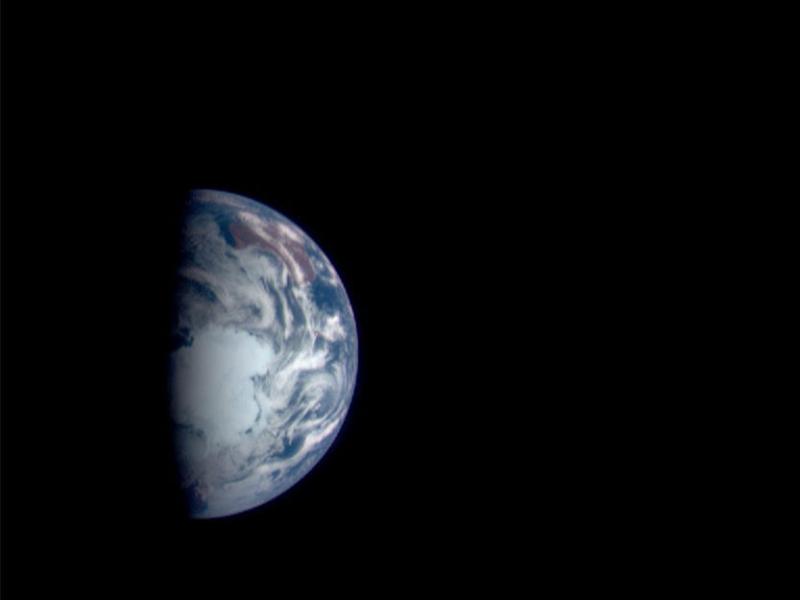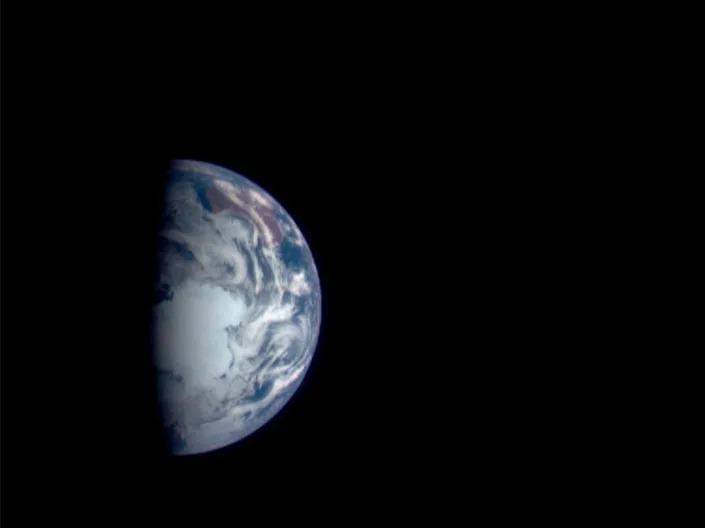The Earth has tilted on its axis differently over the last few decades due to melting ice caps
By: Yahoo News




NEAR Spacecraft Team/JHUAPL/NASA
-
Earth's axis — the invisible line around which it spins — is bookended by the north and south poles.
-
The axis tilts, and thus the pole shift, depending on how weight is distributed across Earth's surface.
-
Melting glaciers have changed that distribution enough to knock Earth off its axis, research showed.
Since 1980, Earth's north and south poles have drifted about 13 feet.
The poles are where the planet's surface intersects with its axis of rotation — the invisible line running through the center of Earth's mass, which it spins around. But their geographic locations aren't fixed: As the Earth's axis moves, so do the poles.
A study published in March 2021 found that Earth's axis started shifting drastically in 1995, speeding the movement of the poles and changing its direction. The culprit behind that shift, the researchers found, was melting glaciers.
Melting ice changes how Earth's weight is distributed
"The trend is mostly driven by the sustained mass change that is happening in the Greenland ice sheet and many glaciers around the globe," said Surendra Adhikari, an Earth scientist of NASA's Jet Propulsion Laboratory.
Adhikari spoke to Insider about the phenomenon and was not involved in the study.
If you average out thousands of years of observation the Earth's axis points in a single direction — toward the North Star, also known as Polaris. But astronomers quickly realized that wasn't always the case. Sometimes, the axis would point at another star, wobble around, then come back to the North Star.
Scientists figured out that Earth's poles can wobble, Adhikari said, even as its angle in relation to the sun stayed consistent. This can be seen in the animation below:
The Earth is not a static ball. Its molten core can shift, ebb and flow. Its crust can squish and expand, depending on what's laying on top of it.
Imagine that the Earth is like a spinning top: If the top's weight is evenly distributed, it should whirl perfectly, without any wobbling to one side or another. But if some of the weight were to shift to one side or the other, that would change the top's center of mass and axis of rotation, leading it to lean toward the heavier side as it spins.
The same thing happens to the Earth when weight moves from one area to another.
Reuters
Sometimes, changes in the distribution of molten rock in Earth's outer core can alter how the planet's mass is distributed. The way water is distributed on Earth's surface also plays a big role.
So when climate change caused a huge melt of glaciers in the planet's polar regions and that water joined the ocean, the weight of that water got spread across a different area.
That redistribution, the 2021 study said, is the main driver of the polar drift scientists have observed in the past few decades.
The trend started around 1995. Before the mid-1990s, satellite data showed that the poles were moving slowly south.
But then they turned left and started shifting to the east at an accelerated rate, moving by about one-tenth of an inch per year. The poles' average drift speed between 1995 and 2020 was 17 times faster than that from 1981 to 1995, the researchers found.
The poles shifted quickly as ice started melting faster due to climate change
That acceleration aligns with accelerated melting around the north and south poles, which has been driven by the planet's rising surface and ocean temperatures.
Greenland has lost more than 4.2 trillion tons of ice since 1992, which has raised global sea levels by 0.4 inches. The rate of that melt increased sevenfold, from 36 billion tons per year in the 1990s to 280 billion tons per year in the past decade. Antarctica's glacial melting is also speeding up.
In the 1980s, Antarctica lost 40 billion tons of ice annually. In the past decade, that number jumped to an average of 252 billion tons per year.
Education Images/Universal Images Group via Getty Images
The study suggested that changes in how much fresh water is stored underground affect polar drift, too. Once humans pump that groundwater to the surface for use as drinking water or for agriculture, it eventually flows into rivers and oceans, redistributing that water weight to Earth's surface.
Nearly 20 trillion tons of groundwater have been pumped out of the Earth since the 1950s, The Guardian reported.
Local weather can also have a (small) effect
The spin axis of the Earth doesn't move steadily in one direction. Within a year it might also wiggle back and forth.
These wiggles are influenced by a combination of "everything that's happening on the planet" over decades, Adhikari said. That makes it difficult to tell exactly what has caused a big shift in the axis.
In a 2016 study, Adhikari and his colleagues were able to trace back an "interannual" wiggle to extreme rain and droughts. Extremely waterlogged soil is very heavy, whereas an extreme drought can suddenly make the soil very light. That's enough to knock the Earth off its axis — slightly.
"This year as we speak in California we have been having, fortunately, a lot of rain, which is a good thing because we had a super drought for the past many years," Adhikari said in the interview in March 2023.
"If you generalize this idea globally, depending upon the pattern of the water mass distribution, we could see its impact on the rotation," said Adhikari.
Our days might be a tiny bit longer
Earth's axis of rotation isn't straight up and down like the axes of Mercury or Jupiter, but tilted at an angle of 23.5 degrees. That's why the northern and southern hemispheres get varying amounts of sunlight at different times of the year, which is why we have seasons.
The recent change to Earth's axis won't affect our everyday lives, but it could slightly tweak the length of our days.
Earth takes just under 24 hours to complete one rotation. But the movement of its axis, and therefore its poles, could add milliseconds to that spin time, making our days a tiny bit longer.
Still, Adhikari warns that there's no reason to panic.
"The magnitude of the spin axis change here is really, really small," he said.
"In principle, it does impact the way how the planet gives solar insulation and stuff like that. But let's be clear that this would be a tiny, tiny, tiny effect," he said.
This post was first published in April 2021 and has been updated to include extra information.




Maybe it's not entirely a human driven problem. This is an aspect that many don't consider when talking about climate change.
I know that no scientist has ever said that the earth's warming was totally human-driven, but what they have said is that we are exacerbating the problem, which then becomes a vicious cycle.
I wasn't referring to the scientists. I am referring to those who want to rule out any natural additional causes. Or that deny them all together.
But this does indicate an element that we have absolutely no control over.
Note, however, that the tilt of the axis has absolutely nothing to do with the increase in CO 2 in our atmosphere. AGW refers to the human contributions to global warming and thus to climate change. Human contributions are measured and historically compared and it is without question that we are the principal reason for the excessive CO 2 , etc. levels in our atmosphere and that these levels are key factors in global warming and thus climate change.
There are other factors contributing to climate change but let's not deflect; let's focus on the problems we have caused and those we can realistically do something about (if not inhibited by deniers).
"These wiggles are influenced by a combination of "everything that's happening on the planet" over decades, Adhikari said. That makes it difficult to tell exactly what has caused a big shift in the axis."
The Earth's wobbles have been occurring for a very long time. I bet it weely wobbled during the Ice Ages when the ice was up to 2,000 feet thick over a large area of the planet.
More info.....
The planet's circumference is something like 24,855 miles. A pole/axis shift of 13 feet since 1980 is miniscule and is not a notable contributor to climate change, nor is a day length change of a few milliseconds.
As mentioned in the article...
I suspect the spoken word was insolation, not insulation, but the takeaway there should be the "tiny, tiny, tiny effect" part.